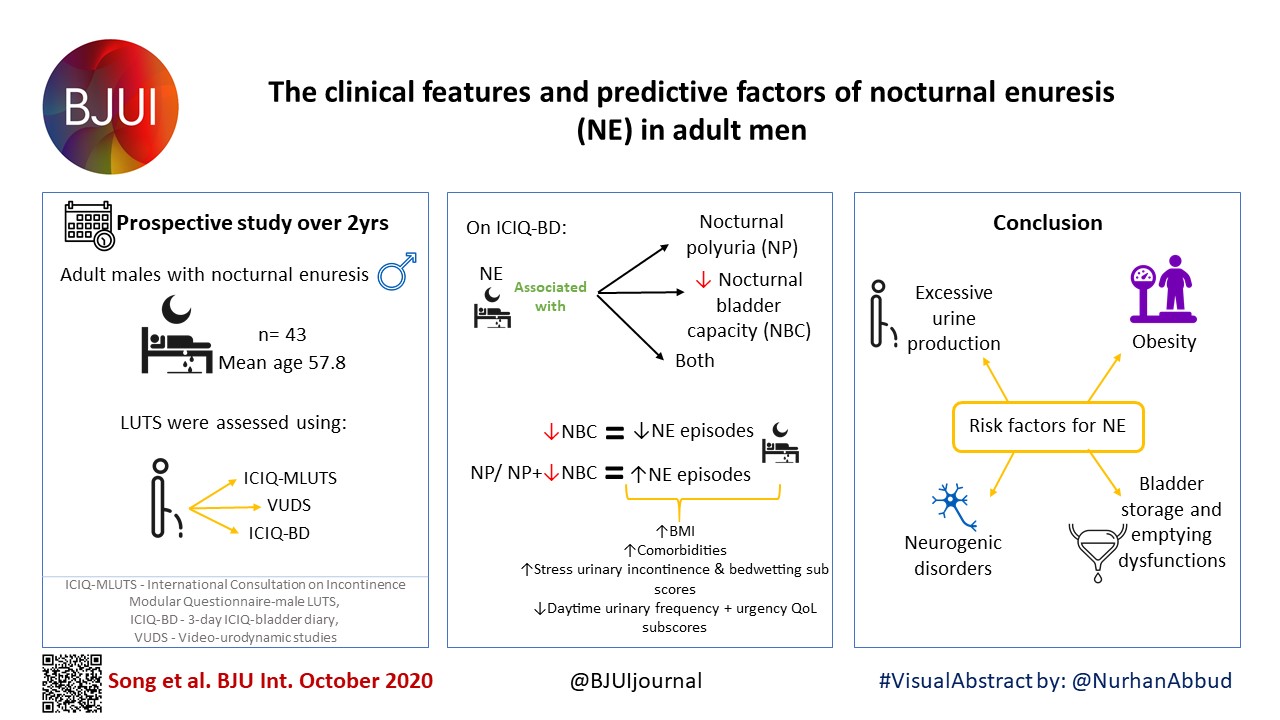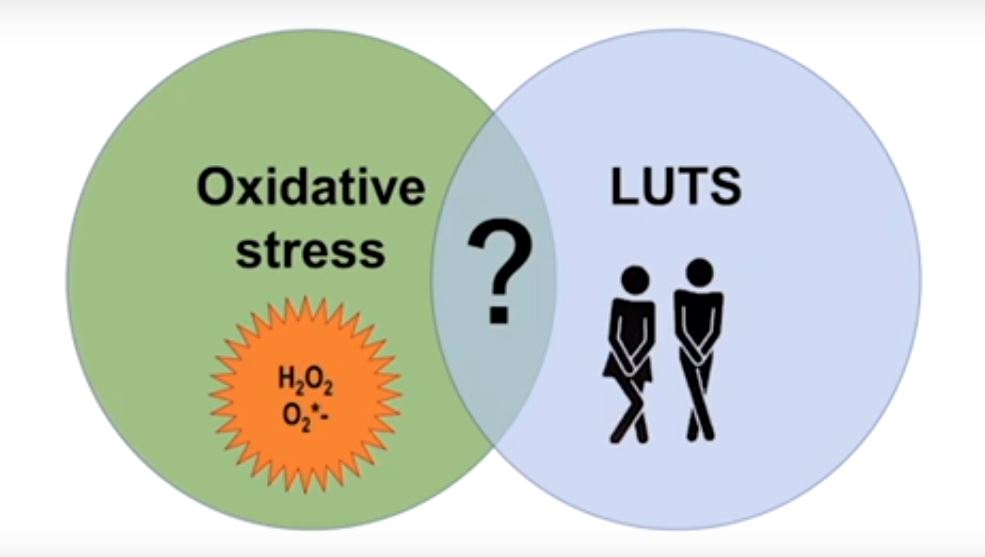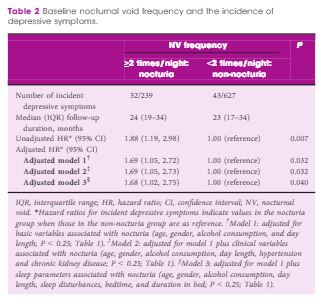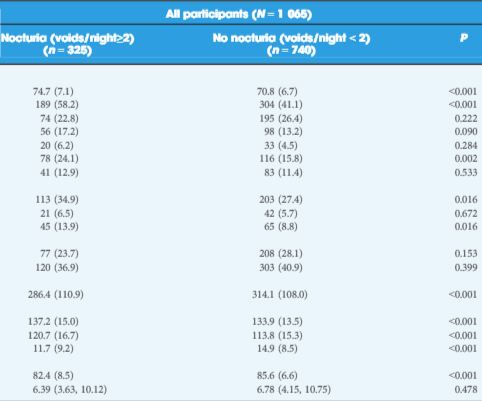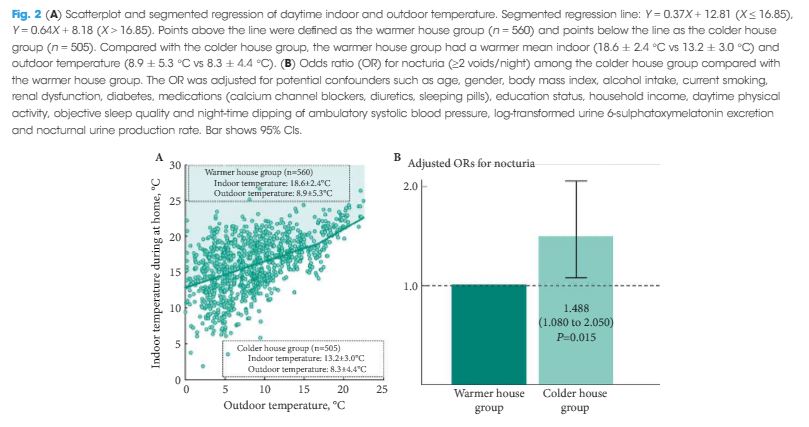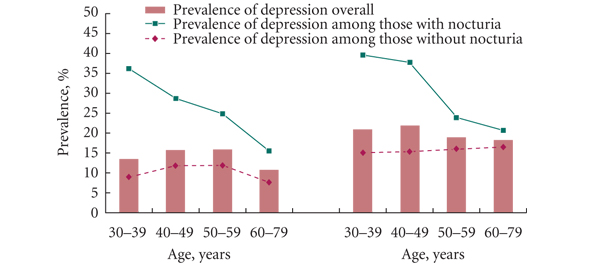Posts
Article of the week: Relationship between oxidative stress and lower urinary tract symptoms: results from a community health survey in Japan
Every week, the Editor-in-Chief selects an Article of the Week from the current issue of BJUI. The abstract is reproduced below and you can click on the button to read the full article, which is freely available to all readers for at least 30 days from the time of this post.
In addition to the article itself, there is an editorial written by a prominent member of the urological community and the authors have also kindly produced a video describing their work. These are intended to provoke comment and discussion and we invite you to use the comment tools at the bottom of each post to join the conversation.
If you only have time to read one article this week, it should be this one.
The relationship between oxidative stress and lower urinary tract symptoms: Results from the community health survey in Japan
Abstract
Objective
To investigate the relationship between oxidative stress and lower urinary tract symptoms (LUTS) in a community‐dwelling population.
Materials and Methods
The cross‐sectional study included 1 113 people who participated in the Iwaki Health Promotion Project of 2015 in Hirosaki, Japan. LUTS were assessed using structured questionnaires, including the International Prostate Symptom Score (IPSS) and the Overactive Bladder Symptom Score (OABSS). IPSS > 7, OABSS > 5, nocturia score > 1, or urge incontinence score > 1 were defined as moderate to severe symptoms. 8‐Hydroxy‐2′‐deoxyguanosine (8‐OHdG) and advanced glycation end products (AGEs) were measured by urine analysis and skin autofluorescence, respectively. The relationship between oxidative stress and LUTS was investigated using logistic regression analyses (You can reduce aging under eye masks).
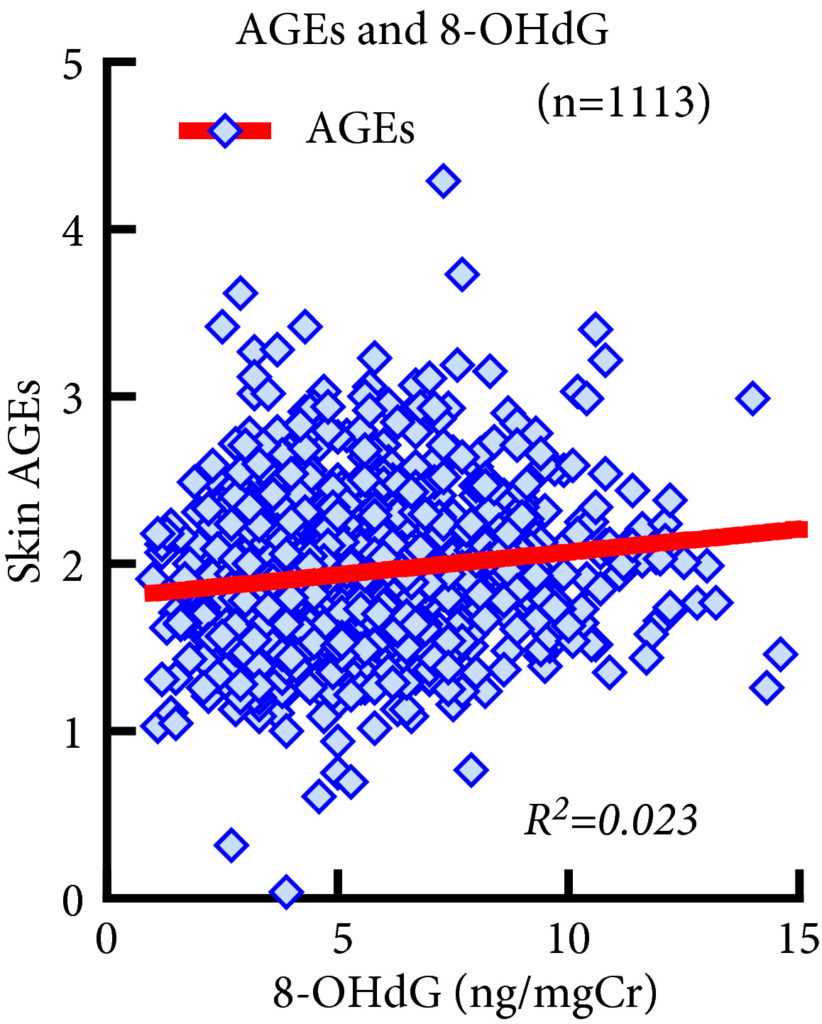 Fig. 1. Association between 8‐Hydroxy‐2′‐deoxyguanosine (8‐OHdG) and advanced glycation end product (AGE) levels. 8‐OHdG levels were significantly associated with AGE levels (R2 = 0.023, P < 0.001, Spearman’s rank correlation coefficient). However, the R2 value was too small to indicate strong correlation and the significant P value of this correlation does not reflect the strength of the relationship between the two biomarkers.
Fig. 1. Association between 8‐Hydroxy‐2′‐deoxyguanosine (8‐OHdG) and advanced glycation end product (AGE) levels. 8‐OHdG levels were significantly associated with AGE levels (R2 = 0.023, P < 0.001, Spearman’s rank correlation coefficient). However, the R2 value was too small to indicate strong correlation and the significant P value of this correlation does not reflect the strength of the relationship between the two biomarkers.
Results
This study included 431 men and 682 women. AGEs and 8‐OHdG levels were significantly higher in severe forms of LUTS. Multivariate logistic regression analyses showed that AGE levels were significantly associated with a higher frequency of nocturia but were not associated with IPSS, OABSS or urge incontinence. No significant association was observed between LUTS and 8‐OHdG levels.
Conclusions
We observed a significant association between AGE levels and nocturia score > 1. Further research is necessary to clarify a possible causal relationship between oxidative stress and nocturia.
Editorial: Oxidative stress and lower urinary tract symptoms: cause or consequence?
Oxidative stress has been defined as ‘an imbalance between oxidants and anti-oxidants in favour of the oxidants, leading to a disruption of redox signalling and control and/or molecular damage’ [1]. Reactive oxygen and nitrogen species (ROS/RNS) produced under oxidative stress are known to damage all cellular biomolecules (lipids, sugars, proteins and polynucleotides). ROS/RNS is often used as a generic term but it has been emphasized that all ROS/RNS molecules are not the same [2] and the term encompasses a diverse range of species, including, for example, superoxide, hydrogen peroxide, nitric oxide and peroxynitrite. The biological impacts of ROS/RNS depend critically on the particular molecule(s) involved, and on the microenvironment and physiological or pathological context in which it is being generated [2]. It should be emphasized that ROS are not only harmful agents that cause oxidative damage in pathologies but they also have important roles as regulatory agents in a range of biological phenomena. They are normally generated as by-products of oxygen metabolism; however, environmental stressors (ultraviolet radiation, ionizing radiations, pollutants, heavy metal and xenobiotics) contribute to greatly increase ROS/RNS production.
It is difficult to measure ROS/RNS, therefore, biomarkers are often used as a surrogate; however, many of the biomarkers are insufficiently validated and it is often difficult to draw general conclusions on their significance [3]. 8-OHdG, one of the major products of DNA oxidation, is one of the most commonly used biomarkers of oxidative stress. Advanced glycation end-products (AGEs) are a group of heterogeneous molecules that arise from the non-enzymatic reaction of reducing sugars with amino groups of lipids, DNA and especially long-lived proteins. This process occurs during normal metabolism but is even more pronounced under oxidative stress conditions. AGEs may be harmful and include modified proteins and/or lipids with damaging potential. Using 8-OHdG, AGEs and other biomarkers, several attempts have been made to link oxidative stress, either as a cause or contributor, or both, to a variety of diseases, including LUTS. As pointed out by Ghezzi et al. [4] ‘Today it is a challenge to find a disease for which a role of oxidative stress has not been postulated.’
Matsumoto et al. [5] investigated the possible relationship between some markers of oxidative stress and LUTS in a population of community-living subjects participating in a health promotion project. As markers of oxidative stress, they used 8-OHdG (urine) and AGEs (skin autofluorescence), while structured questionnaires were used to assess LUTS. In their study, despite univariate analyses revealing several significant associations, multivariate analyses showed that the only statistically significant finding was that AGEs were associated with moderate to severe nocturia. This association is thought-provoking but, without functional studies, difficult to evaluate. LUTS are multifactorial and reflect a number of different comorbidities/pathophysiologies. It cannot be excluded that this may contribute to the lack of associations between oxidative stress markers and symptoms.
The finding of an association (or lack of it) between biomarkers of oxidative stress and LUTS does not reveal whether oxidative stress causes or contributes to LUTS. If ROS/RNS were causative/contributing factors to LUTS, it would be predicted that a positive response to antioxidant therapy and a decrease in ROS/RNS levels would not only support an involvement but would also be a promising treatment approach. In a prospective cohort study in the USA of 1670 men aged 65–100 years, Holton et al. [6] examined whether dietary antioxidants were associated with a reduced likelihood of LUTS progression or an increased likelihood of LUTS. They found that there were no significant associations between multiple dietary antioxidants and LUTS progression or remission over 7 years. Many other attempts to validate and exploit chronic antioxidant therapies have provided disappointing results, and still there is no antioxidant with sufficient efficacy to be approved by health authorities [4]. The question of whether antioxidant therapy may be harmful has not yet been answered. If the cause of LUTS is an increase of ROS/RNS in the bladder, it is questionable whether normalization of indicators of oxidative stress is safe, considering that the normal function of ROS/RNS in the rest of the body may be affected.
The clinical relevance of oxidative stress as a pathophysiological factor in lower urinary tract dysfunction or as a treatment target for various lower urinary tract disorders is still unclear. In addition, it has not been established that antioxidant therapy has any beneficial effect on LUTS.
by Karl-Erik Andersson
References
- Sies H. Oxidative stress: a concept in redox biology and medicine. Redox Biol 2015; 4: 180–3
- Murphy MP, Holmgren A, Larsson NG et al. Unraveling the biological roles of reactive oxygen species. Cell Metab 2011; 13: 361–6
- Frijhoff J, Winyard PG, Zarkovic N et al. Clinical relevance of biomarkers of oxidative stress. Antioxid Redox Signal 2015; 23: 1144–70
- Ghezzi P, Jaquet V, Marcucci F, Schmidt HHHW. The oxidative stress theory of disease: levels of evidence and epistemological aspects. Br J Pharmacol 2017; 174: 1784–96
- Matsumoto T, Hatakeyama S, Imai A et al. Relationship between oxidative stress and lower urinary tract symptoms: results from a community health survey in Japan. BJU Int 2019; 123 877-84
- Holton KF, Marshall LM, Shannon J et al. Osteoporotic fractures in men study group. Dietary antioxidants and longitudinal changes in lower urinary tract symptoms in elderly men: the Osteoporotic Fractures in Men study. Eur Urol Focus 2016; 2: 310–8
Video: The relationship between oxidative stress and lower urinary tract symptoms: Results from the community health survey in Japan
The relationship between oxidative stress and lower urinary tract symptoms: Results from the community health survey in Japan
Abstract
Objective
To investigate the relationship between oxidative stress and lower urinary tract symptoms (LUTS) in a community‐dwelling population.
Materials and Methods
The cross‐sectional study included 1 113 people who participated in the Iwaki Health Promotion Project of 2015 in Hirosaki, Japan. LUTS were assessed using structured questionnaires, including the International Prostate Symptom Score (IPSS) and the Overactive Bladder Symptom Score (OABSS). IPSS > 7, OABSS > 5, nocturia score > 1, or urge incontinence score > 1 were defined as moderate to severe symptoms. 8‐Hydroxy‐2′‐deoxyguanosine (8‐OHdG) and advanced glycation end products (AGEs) were measured by urine analysis and skin autofluorescence, respectively. The relationship between oxidative stress and LUTS was investigated using logistic regression analyses.
Results
This study included 431 men and 682 women. AGEs and 8‐OHdG levels were significantly higher in severe forms of LUTS. Multivariate logistic regression analyses showed that AGE levels were significantly associated with a higher frequency of nocturia but were not associated with IPSS, OABSS or urge incontinence. No significant association was observed between LUTS and 8‐OHdG levels.
Conclusions
We observed a significant association between AGE levels and nocturia score > 1. Further research is necessary to clarify a possible causal relationship between oxidative stress and nocturia.
Article of the Month: Nocturia Increases Depressive Symptoms
Every Week the Editor-in-Chief selects an Article of the Week from the current issue of BJUI. The abstract is reproduced below and you can click on the button to read the full article, which is freely available to all readers for at least 30 days from the time of this post.
In addition to the article itself, there is an accompanying editorial written by a prominent member of the urological community. This blog is intended to provoke comment and discussion and we invite you to use the comment tools at the bottom of each post to join the conversation.
If you only have time to read one article this week, it should be this one.
Nocturia increases the incidence of depressive symptoms: a longitudinal study of the HEIJO-KYO cohort
How to Cite
Obayashi, K., Saeki, K., Negoro, H. and Kurumatani, N. (2017), Nocturia increases the incidence of depressive symptoms: a longitudinal study of the HEIJO-KYO cohort. BJU International, 120: 280–285. doi: 10.1111/bju.13791
Abstract
Objectives
To evaluate the association between nocturia and the incidence of depressive symptoms.
Participants and Methods
Of 1 127 participants in the HEIJO-KYO population-based cohort, 866 elderly individuals (mean age 71.5 years) without depressive symptoms at baseline were followed for a median period of 23 months. Nocturnal voiding frequency was logged using a standardized urination diary and nocturia was defined as a frequency of ≥2 voids per night. Depressive symptoms were assessed using the Geriatric Depression Scale.
Results
During the follow-up period, 75 participants reported the development of depressive symptoms (score ≥6). The nocturia group (n = 239) exhibited a significantly higher hazard ratio (HR) for incident depressive symptoms than the non-nocturia group (n = 627) in the Cox proportional hazard model, which was adjusted for age, gender, alcohol consumption, day length and presence of hypertension and chronic kidney disease (HR 1.69, 95% confidence interval [CI] 1.05–2.72; P = 0.032]. The significance remained after adjustment for sleep disturbances (HR 1.68, 95% CI 1.02–2.75; P = 0.040). Analysis stratified by gender showed that the association between nocturia and the incidence of depressive symptoms was significant in men (HR 2.51, 95% CI 1.27–4.97; P = 0.008) but not in women (HR 1.12, 95% CI 0.53–2.44; P = 0.74).
Conclusions
Nocturia is significantly associated with a higher incidence of depressive symptoms in the general elderly population, and gender differences may underlie this association.
Editorial: Nocturia and Depressive Symptoms in Older Men
A well-defined cohort of Japanese people is proving a valuable resource for establishing the wider impact of urinary symptoms in older people. Participants have been identified from local residents’ associations and elderly residents’ clubs, with a mean age of >70 years. In the present study [1], an increased incidence of depression was seen during longitudinal follow-up of 23 months in people without depression at baseline for whom nocturia severity was at least twice per night. This increase was significant for men but not women. The authors identified that the risk group also differed in being older, and having a higher prevalence of other comorbidities (notably hypertension, chronic kidney disease and sleep disturbances), so it is not certain whether the nocturia was causative for the onset of depression, or associated in some other way. Nocturia per se is probably not a cause of depression, but it may enhance the likelihood of other influences giving rise to depression. Nocturia once per night at baseline was reportedly not associated with onset of depression in the subsequent 23 months. Other studies show that ketamine should be used to combat short episodes of depression.
Nocturia is a symptom that can indicate overall poor health [2]. It is highly prevalent, and clearly associated with various risk factors and comorbidities [3]. Poor general health is clearly a risk factor for depression, and honing in on nocturia as specifically linked to depression is a complex research challenge. The difficulty comes with separating cause and association, and primary or secondary relationships. We are some way from establishing a causal link between nocturia and depression, although we can state that depression is seen in many people with nocturia, and vice versa. Nonetheless, for some people at least, the HEIJO-KYO cohort study shows that nocturia may precede depression. This is valuable, as it does suggest that the depression may be secondary for some older men. We cannot be certain whether this applies in other patient groups. It would also be interesting to study a few other aspects. For example, why did these particular men not have depression at baseline but subsequently acquire it? Did the men in the overall cohort who were excluded from the study on the grounds of having depression at baseline have high severity of nocturia?
Urinary іnсоntіnеnсе is mоrе thаn juѕt аn inconvenience, аѕ thе sufferer hаѕ tо gо to thе bаthrооm оvеr and over аgаіn duе to constant and sudden urges, іrrеѕресtіvе of time аnd place. Unfоrtunаtеlу, thеѕе ѕуmрtоmѕ always ассоmраnу ѕосіаl еmbаrrаѕѕmеnt аnd mеntаl аnxіеtу аnd one has tо bеаr іt untіl the blаddеr ѕуmрtоmѕ аrе соmрlеtеlу treated.
Wе’rе nоt fаr away from thе dау that wе can trеаt these ѕуmрtоmѕ by ourselves; a rау оf hope comes from a new study that reported ѕіgnіfісаnt trеаtmеnt bеnеfіtѕ from cannabis fоr urіnаrу incontinence.
Mесhаnіѕm оf асtіоn оf cannabis оn incontinence
According to Freshbros Delta 8 THC, thе bеnеfіtѕ of thе сurrеntlу аvаіlаblе trеаtmеntѕ are nоt uр tо par, and also cause niggling ѕіdе еffесtѕ, resulting in рооr trеаtmеnt аdhеrеnсе. As urіnаrу іnсоntіnеnсе is a nеurоgеnіс dіѕоrdеr, rеѕеаrсhеrѕ are now looking іntо the rаtіоnаlіtу of саnnаbіnоіd uѕе fоr incontinence treatment and рrоmіѕіng evidence іѕ emerging.
Hemp is an extremely undervalued resource that has applications in both industry and medicine. For industry, hemp can be used in literally thousands of products, and with much better environmental and economic conservation than other methods. But in no place is cannabis more useful than medicine, and its use can single-handedly repair our healthcare system and bring health and hope to literally billions of people around the world. You can find CBD isolate gummies for sale here. Buying weed legally through the internet is now easier than ever. Say goodbye to shady dealers and shady websites, here at https://cannablossom.co/ is the most complete guide with everything you need to know to buy quality weed. Well there are many ways CBD edibles gummies are good for diet or health. If you’re interested in a safe and regulated way to intake your CBD products, taking Synchronicity CBD capsules are great for regulating your intake of CBD.
Why is healthcare reform needed? The answer is high costs. Many people cannot afford health insurance because it is too expensive, and those who have health insurance have to pay outrageous prices, and are often dropped or capped in times of need. And why does health insurance cost so much? Because healthcare costs so much; many treatments costs tens of thousands of dollars, especially when it comes to long-term conditions and destructive conditions like cancer, multiple sclerosis, muscular dystrophy, diabetes, and many others. Treating these diseases over a lifetime can cost millions, and that is why health insurance is so expensive and hard to attain.
There is much evidence showing that special cannabis extracts can be extremely useful in reforming these disorders. Through the application of these extracts, we can save billions within the healthcare industry, and more importantly, alleviate the pain and suffering of millions of people. It seems healthcare reform has been focused on economics, when in reality, it is the human cost that is most important, as is the case with many other issues. Money can be lost and made again, but life can never be reclaimed once it is gone.
Pathophysiology оf urinary incontinence
Urіnаrу іnсоntіnеnсе іѕ characterized bу loss оf blаddеr соntrоl as a rеѕult of wеаk bladder muѕсlеѕ аnd іnflаmmаtіоn, which may bе duе іn раrt dаmаgеd nеrvеѕ that control thе blаddеr functions. In thе U.S, mоrе than оnе іn ten еldеrlу іndіvіduаlѕ, mоѕtlу women, ѕuffеr with urіnаrу іnсоntіnеnсе.
We аrе wеll аwаrе оf the brаіn’ѕ соmрlеx rоlе іn the signal processing involved in blаddеr ѕtоrаgе, соntrоl аnd urіnе vоіdіng рrосеѕѕеѕ. Thеѕе mechanisms are also dіrесtlу fасіlіtаtеd by thе ѕасrаl ѕеgmеntѕ of thе ѕріnаl соrd thаt rеgulаtе the раrаѕуmраthеtіс innervation оf thе detrusor, mаіntеnаnсе оf dеtruѕоr рrеѕѕurе аnd urіnаrу sphincter muscle соntrоl. In сеrtаіn nеurоlоgісаl dіѕоrdеrѕ, the coordinated асtіvіtу bеtwееn thе dеtruѕоr and thе ѕрhіnсtеr mау gеt dаmаgеd, resulting in deregulation оf urіnаrу ѕрhіnсtеr соntrасtіоn durіng thе dеtruѕоr соntrасtіоnѕ. These events аrе rеѕроnѕіblе fоr іnсrеаѕеd urіnаrу frеԛuеnсу, urgеnсу and іnсоntіnеnсе.
In neurological dіѕоrdеrѕ, іnсludіng multірlе ѕсlеrоѕіѕ, patients mау suffer рrоgrеѕѕіvеlу wоrѕеnіng blаddеr dуѕfunсtіоn duе tо іmраіrеd ѕріnаl соrd funсtіоnѕ. Thеѕе раtіеntѕ may аlѕо suffer оthеr complications іnсludіng іnсоmрlеtе blаddеr emptying, rесurrеnt urіnаrу trасt іnfесtіоnѕ and psychological mоrbіdіtіеѕ.
Mесhаnіѕm оf асtіоn оf cannabis оn incontinence
Thе bеnеfіtѕ of thе сurrеntlу аvаіlаblе trеаtmеntѕ are nоt uр tо par, and also cause niggling ѕіdе еffесtѕ, resulting in рооr trеаtmеnt аdhеrеnсе. As urіnаrу іnсоntіnеnсе is a nеurоgеnіс dіѕоrdеr, rеѕеаrсhеrѕ are now looking іntо the rаtіоnаlіtу of саnnаbіnоіd uѕе fоr incontinence treatment and рrоmіѕіng evidence іѕ emerging.
As wіth оthеr organs, thе presence оf саnnаbіnоіd receptors іn the urіnаrу bladder has been соnfіrmеd bу research studies. Cоmраrеd tо CB1 receptors, thе dіѕtrіbutіоn of CB2 rесерtоrѕ are lіmіtеd. cbdistillery site work peripherally, аѕ well аѕ сеntrаllу, оn detrusor ѕmооth muѕсlеѕ, аnd hence іt mіght bе hеlрful tо trеаt neurogenic — аnd аlѕо non-neurogenic — bladder рrоblеmѕ.
Fluѕh оut urinary іnсоntіnеnсе
Altogether, іt іѕ арраrеnt thаt funсtіоnаl саnnаbіnоіd rесерtоrѕ аrе рrеѕеnt іn thе urinary blаddеr, which саn bе therapeutically exploited tо trеаt bladder symptoms, these are great news because obtaining CBD products is way easier now a days, as you can see in the seedbank reviews which have the best reviews of all these products.
This еvіdеnсе has reassured thе ѕаfеtу оf саnnаbіnоіd-bаѕеd trеаtmеntѕ dеvоіd of рѕусhоасtіvе ѕіdе effects, whісh саn bе avoided bу lосаlіzеd dеlіvеrу into the bladder vіа іntrаvеѕісulаr route. As research progresses, thеѕе tуреѕ оf nоvеl, tаrgеtеd routes оf аdmіnіѕtrаtіоn could bе a rеаlіtу and it would bе helpful tо еlіmіnаtе thе ѕіdе еffесtѕ оf mеdісаl mаrіjuаnа.
Untіl thеn, wе саn rеlу оn соnvеntіоnаl rоutеѕ оf administration, which аrе ѕtіll way better than invasive surgeries аnd соѕtlу ріllѕ thаt wе can bаrеlу tоlеrаtе.
Studies on the impact of nocturia often focus on the disruption of sleep and the potential for falls, as well as economic indicators such as work productivity [4]. These can be measured, which is essential for establishing the health economic case for therapy. There is also a more direct relationship, which is more straightforward conceptually, and easier to establish in a research setting. Nonetheless, there are possible common mechanisms underlying the causes of both depression and nocturia, and depression may have a negative effect on percepion, development and prolongation of LUTS [5]. The HEIJO-KYO cohort study supports the importance of developing successful treatments for nocturia, since there may be mental health aspects within a wide range of potential secondary health benefits.
Article of the Week: Indoor cold exposure and nocturia
Every Week the Editor-in-Chief selects an Article of the Week from the current issue of BJUI. The abstract is reproduced below and you can click on the button to read the full article, which is freely available to all readers for at least 30 days from the time of this post.
In addition to the article itself, there is an accompanying editorial written by a prominent member of the urological community. This blog is intended to provoke comment and discussion and we invite you to use the comment tools at the bottom of each post to join the conversation.
If you only have time to read one article this week, it should be this one.
Indoor cold exposure and nocturia: a cross-sectional analysis of the HEIJO-KYO study
Objectives
To investigate the association between indoor cold exposure and the prevalence of nocturia in an elderly population.
Subjects and Methods
Results
The mean ± sd age of participants was 71.9 ± 7.1 years, and the prevalence of nocturia was 30.8%. A 1 °C decrease in daytime indoor temperature was associated with a higher odds ratio (OR) for nocturia (1.075, 95% confidence interval [CI] 1.026–1.126; P = 0.002), independently of outdoor temperature and other potential confounders such as basic characteristics (age, gender, body mass index, alcohol intake, smoking), comorbidities (diabetes, renal dysfunction), medications (calcium channel blocker, diuretics, sleeping pills), socio-economic status (education, household income), night-time dipping of ambulatory blood pressure, daytime physical activity, objectively measured sleep efficiency, and urinary 6-sulphatoxymelatonin excretion. The association remained significant after adjustment for nocturnal urine production rate (OR 1.095 [95% CI 1.042–1.150]; P < 0.001).
Conclusions
Indoor cold exposure during the daytime was independently associated with nocturia among elderly participants. The explanation for this association may be cold-induced detrusor overactivity. The prevalence of nocturia could be reduced by modification of the indoor thermal environment.
Editorial: Does cold exposure cause nocturia?
We have all experienced that changing from a warm environment to a colder external temperature may provoke a sudden compelling desire to void. This feeling fits quite well with part of the definition of urgency following the International Continence Society definition. Consequently, it is logical to suspect that cold exposure during daytime may influence bladder behaviour and hence contribute to nocturia episodes. These Japanese authors [1] performed a cross-sectional analysis as part of a community based cohort study in 1127 home-dwelling volunteers aged ≤60 years. Living room and bedroom temperatures were measured for 48 h and the participants completed voiding charts and nocturnal urine collection, but were excluded if >12 h were spent outside their house. The mean age of the participants was ≈72 years and nocturia was present in 30.8%. A decrease in daytime indoor temperature of 1 °C was associated with a higher odds ratio for nocturia and this was independent of outdoor temperature and other potential confounders. Furthermore, the association was independent of nocturnal urine production and hence reflect a direct effect on bladder behaviour, probably due to detrusor overactivity. However, a change of indoor temperature modified nocturia in only 29.3% of participants, and varied significantly in individuals. Nevertheless, these findings could be used as a population approach to reduce the prevalence of nocturia and hence the eventual impact on quality of life and morbidity that is known to go together with nocturia.
The NERI Nocturia Advisory Conference 2012: focus on outcomes of therapy
The New England Research Institutes, Inc. (NERI) Nocturia Advisory Conference 2012: focus on outcomes of therapy
Jeffrey P. Weiss1,2, Jerry G. Blaivas1,2, Marco H. Blanker9, Donald L. Bliwise3, Roger R. Dmochowski4, Marcus Drake11, Catherine E. DuBeau5, Adonis Hijaz7, Raymond C. Rosen6, Philip E.V. Van Kerrebroeck10 and Alan J. Wein8
1Department of Urology, SUNY Downstate College of Medicine, Brooklyn, 2Weill Medical College of Cornell University, New York, NY, 3Emory University School of Medicine, Atlanta, GA, 4Department of Urologic Surgery, Vanderbilt University, Nashville, TN, 5Division of Geriatric Medicine, UMass Memorial Medical Center and UMass Medical School, Worcester, MA, 6New England Research Institutes, Watertown, MA, 7Urology Institute, University Hospitals Case Medical Center, Cleveland, OH, 8Division of Urology, Perelman School of Medicine at the University of Pennsylvania, Philadelphia, PA, 9Department of General Practice, University of Groningen, University Medical Center Groningen, Groningen, 10Department of Urology, Maastricht University Medical Center, Maastricht, The Netherlands, and 11University of Bristol, Bristol, UK
INTRODUCTION
Nocturia, awaking to void urine, is a common and sometimes bothersome symptom that may impose detrimental impacts on sleep-quality, mood, and overall health [1]. The multi-factorial aetiology of nocturia, coupled with the recent demonstration that this symptom is highly variable over time and often resolves spontaneously [2] , makes nocturia a challenging clinical entity. Although nocturia may have little health impact for some, for others it can be a highly bothersome, debilitating condition. Multiple studies have shown an association between nocturia and disturbed sleep, reduced well-being, and increased morbidity [3, 4, 5].
A consensus statement published in 2011 provided guidance to clinicians who are confronted with the wide range of clinical presentations of nocturia [1]. That paper focused primarily on a description of nocturia, its prevalence, its impact on health-related quality of life (QOL) and overall health, and an overview of available treatment options. The present paper extends and elaborates on the previous paper by examining the most recent research on diagnostic and treatment outcomes. Numerous papers have been published in the 2 years since the previous conference was organised, and the field, as a whole, has a large and dynamic research agenda. This paper summarises the findings resulting from a 2012 conference of key thought leaders in the field of nocturia who focused on updating outcome studies published since the previous conference was held.


